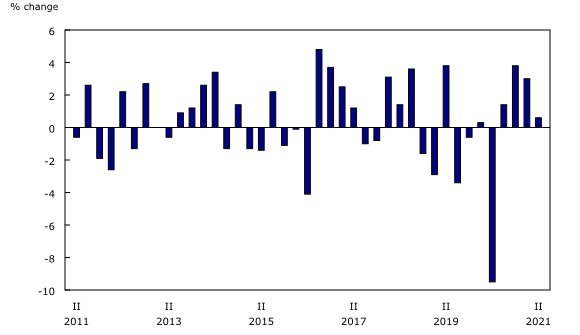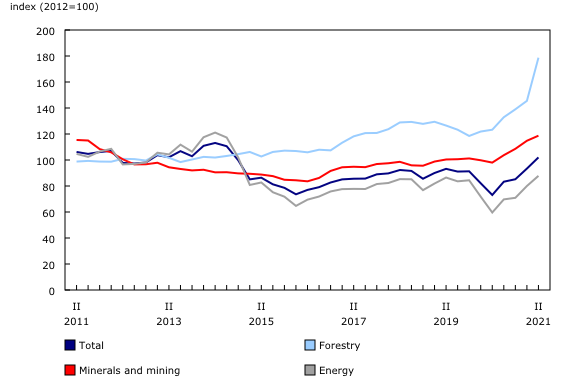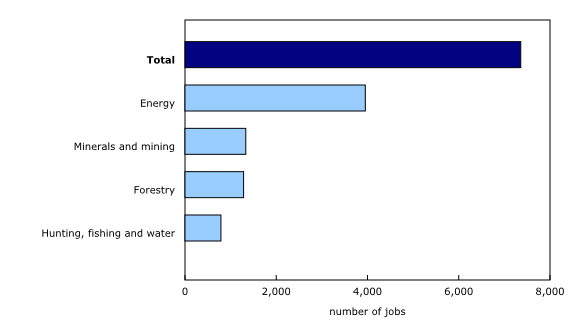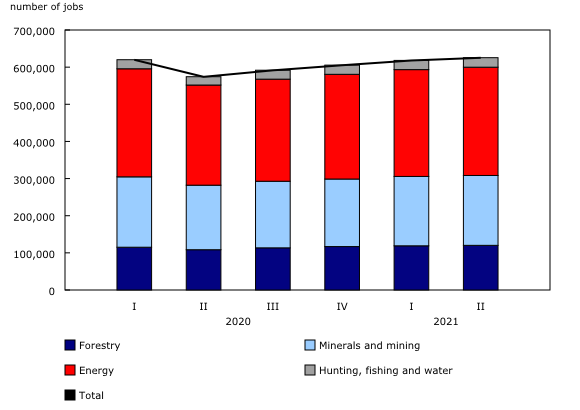Natural resource indicators, second quarter 2021
Archived Content
Information identified as archived is provided for reference, research or recordkeeping purposes. It is not subject to the Government of Canada Web Standards and has not been altered or updated since it was archived. Please "contact us" to request a format other than those available.
Released: 2021-09-22
Natural resources real gross domestic product on the rise
Real gross domestic product (GDP) of the natural resources sector rose 0.6% in the second quarter of 2021, the fourth consecutive quarterly increase. Real GDP of the natural resources sector has still not fully recovered from the 9.5% drop caused by the pandemic in the second quarter of 2020.
The rise in the natural resources sector real GDP was stronger than economy-wide real GDP (-0.3%), reflecting growing demand for natural resource products as many sectors begin to recover from the pandemic.
The second quarter increase in real natural resource GDP was broad-based.
Real GDP of the energy subsector edged up 0.3% due to increased consumption. This was the lowest energy growth rate since natural resources started recovering from the pandemic-related declines in 2020.
Real GDP of the minerals and mining subsector (+0.9%) rose in the second quarter, as production followed increased demand. This was the fourth consecutive quarterly increase.
Non-metallic minerals rose 1.4% in the second quarter, following a 6.6% increase in the previous quarter due to increased potash and diamond demand. Metallic minerals real GDP increased 1.1% over the same period, driven by the strength of iron ore production.
Real GDP of the forestry subsector was up 1.3%, the fourth straight quarterly increase. This was largely due to a consistently high demand for lumber caused by a rise in housing investment. In the second quarter, investment increased in both new housing construction (+3.2%) and renovations (+2.4%).
Hunting, fishing and water real GDP was up 1.4% in the second quarter.
Export volumes fall and import volumes rise
Natural resources export volumes fell 4.3% in the second quarter, following a 1.5% rise in the first quarter of 2021. Exports of forestry (+4.5%) were being fuelled in the second quarter by the growth in the US residential construction market. Minerals and mining (+1.7%) rose due to increased exports of non-metallic minerals. Energy exports fell 9.0% due to reduced energy demand from trading partners.
Hunting, fishing and water exports rose strongly (+52.9%) in the second quarter, led by the strongest exports in prepared and packaged sea food products since 2007, when this category was first recorded in the Natural Resources Satellite Account. Restrictions faced by dine-in restaurants led to strong increases in exports, as supply was redirected to international markets, including the United States.
The increase in import volumes (+1.5%) was led by forestry (+5.3%), followed by energy (+4.1%). Imports were led by increased demand for raw materials from manufacturers returning to full capacity as they recover from lockdowns. Imports in the minerals and mining subsector decreased by 1.2% and hunting, fishing and water imports were stable (0.0%).
Natural resource prices and nominal GDP increase
Overall, natural resources prices rose 9.3% in the second quarter, led by a 22.7% gain in forestry prices due to higher demand for primary sawmill and wood products.
A 33.8% increase in primary sawmill and wood contributed to the rise in overall natural resources nominal GDP (+9.9%). This was reflected in the nominal GDP of the forestry subsector, which rose 24.3%. Nominal GDP of the minerals and mining subsector was up 4.4%, while energy increased 10.2%. Expressed at an annual rate, nominal natural resources GDP was $259 billion in the second quarter, representing 11.2% of the Canadian economy.
Employment continues to rise
Employment in the natural resources sector rose 1.2%, the fourth consecutive quarterly gain. Job recovery was strongest in the energy subsector (+4,000 jobs), followed by minerals and mining (+1,300 jobs) and forestry (+1,300 jobs).
Almost all of the losses in natural resources employment stemming from the pandemic have been recovered, but employment numbers are still below 2019 levels. Forestry jobs have grown 4.4% since the first quarter of 2020, whereas minerals and mining (-0.7%) and energy (+0.2%) are experiencing a slower recovery. Hunting, fishing and water jobs were mostly unaffected by COVID-related restrictions, and 800 jobs were created in this sector in the second quarter of 2021.
Downstream activities increase
For analytical purposes, secondary and tertiary processing for the forestry and minerals and mining subsectors are identified separately. The nominal GDP of these downstream activities rose 3.2% to $8.7 billion in the second quarter. Prices increased 4.5% in the second quarter, following a 5.7% increase in the first quarter of 2021.
Note to readers
Data on natural resources for the second quarter of 2021 have been released along with revised data from the first quarter of 2021.
The natural resources indicators are quarterly indicators for the main aggregates in the Natural Resource Satellite Account (NRSA), namely, gross domestic product, output, exports, imports and employment. The estimates from this account are directly comparable to the estimates in the Canadian System of Macroeconomic Accounts.
Employment estimates reported in this release align with the following definitions of natural resource subsectors. Consequently, these estimates may differ from those released by the labour productivity program.
Core natural resources: The NRSA defines natural resource activities as those that result in goods and services originating from naturally occurring assets used in economic activity, as well as their initial processing (primary manufacturing).
Downstream activities: Although not part of the core account, natural resources have important downstream effects on other sectors. In general, this production uses a large portion of primary manufactured products as inputs.
Next release
Data on natural resource indicators for the third quarter of 2021 will be released on January 14, 2022.
Products
The Economic Accounts Statistics portal, accessible from the Subjects module of our website, features an up-to-date portrait of national and provincial economies and their structures.
Additional information can be found in the articles "The Natural Resources Satellite Account: Feasibility study" and "The Natural Resources Satellite Account – Sources and methods," which are part of the Income and Expenditure Accounts Technical Series (13-604-M).
The Latest Developments in the Canadian Economic Accounts (13-605-X) is available.
The User Guide: Canadian System of Macroeconomic Accounts (13-606-G) is available.
The Methodological Guide: Canadian System of Macroeconomic Accounts (13-607-X) is available.
Contact information
For more information, or to enquire about the concepts, methods or data quality of this release, contact us (toll-free 1-800-263-1136; 514-283-8300; STATCAN.infostats-infostats.STATCAN@canada.ca) or Media Relations (613-951-4636; STATCAN.mediahotline-ligneinfomedias.STATCAN@canada.ca).
- Date modified:






